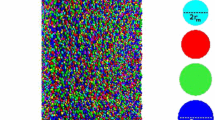Abstract
During the discharge of a two-dimensional silo, the flow of grains through an opening is arrested if the size of the outlet is not large enough. In the outpouring of grains, jamming occurs due to the formation of an arch at the outlet. After breaking the arch, the grains fall until a new arch is formed. Several models have been proposed to explain this process. The goal of this work is twofold. First, we developed a comparative study of the models proposed by Janda et al. (Europhys Lett 84(4):44002-1–44002-6, 2008) and To (Phys Rev E 71(6):060301-1–060301-4, 2005). We have computed D-optimal and c-optimal designs for the most important parameter of the models. Secondly, using the criterion of KL-optimality developed by López-Fidalgo et al. (J R Stat Soc Ser B 69(2):231–242, 2007), optimal designs for discriminating between these models have been computed.





Similar content being viewed by others
References
Amo-Salas M, Delgado-Márquez E, López-Fidalgo J (2015) Optimal experimental designs in the flow rate ofparticles. Technometrics 58(2):269–276
Atkinson AC, Cox DR (1974) Planning experiments for discriminating between models. With discussion by Wynn HP, Titterington DM, Laycock PJ, Lindley DV, Hill DH, Herzberg AM, Tukey PA, O’Hagan A, Fedorov VV, Dickey J, Kiefer J, Smith CAB. J Roy Statist Soc Se. B. 36(3):321–348
Atkinson AC, Donev A, Tobias R (2007) Optimum experimental designs with SAS. Oxford University Press, Great Britain
Atkinson AC, Fedorov VV (1975) Optimal design: experiments for discriminating between several models. Biometrika 62(2):289–303
Fedorov VV (1972) Theory of optimal experiments. Academic Press, New York
Fedorov VV, Hackl P (1997) Model-oriented design of experiments. Spinger, New York
Janda A, Zuriguel I, Garcimartin A, Pugnaloni LA, Maza D (2008) Jamming and critical outlet size in the discharge of a two-dimensional silo. Europhys Lett 84(4):44002-1–44002-6
López-Fidalgo J, Rodrìguez Dìaz JM (2004) Elfving’s method form—dimensional models. Metrika 59:235–244
López-Fidalgo J, Tommasi Ch, Trandafir PC (2007) An optimal experimental design criterion for discriminating between non-normal models. R Stat Soc Ser B 69(2):231–242
Pukelsheim F (1993) Optimal design of experiments. John Wiley and Sons, New York
To K (2005) Jamming transition in two-dimensional hoppers and silos. Phys Rev E 71(6):060301-1–060301-4
Ucinski D, Bogacka B (2004), T\(-\)optimum designs for multiresponse dynamic heteroscedastic models. In: Proceedings of the 7th international workshop on model-oriented design and analysis (MODA7). Spinger, pp. 191–199
Author information
Authors and Affiliations
Corresponding author
Additional information
The authors are supported by Ministerio de Economía y Competitividad and Fondos FEDER MTM2010–20774-C03-01 and MTM2013–47879-C2-1-P and Junta de Comunidades de Castilla la Mancha PEII10–0291-1850 and by the Slovak VEGA-Grant No. 1/0521/16. The authors would like to thank the associate editor and the referees for their comments, which have contributed very much to improve the paper.
Rights and permissions
About this article
Cite this article
Amo-Salas, M., Delgado-Márquez, E., Filová, L. et al. Optimal designs for model discrimination and fitting for the flow of particles. Stat Papers 57, 875–891 (2016). https://doi.org/10.1007/s00362-016-0792-5
Received:
Revised:
Published:
Issue Date:
DOI: https://doi.org/10.1007/s00362-016-0792-5




